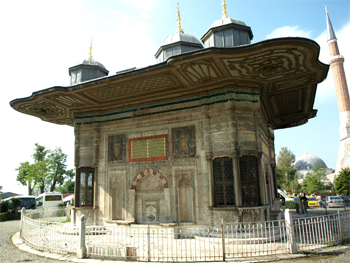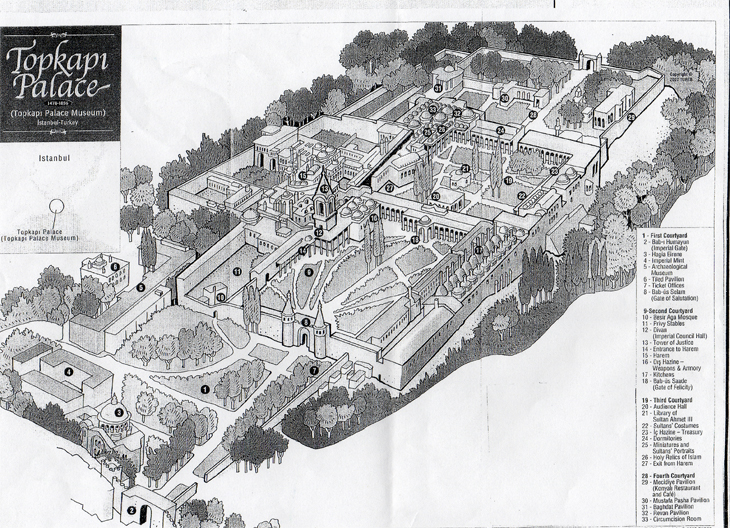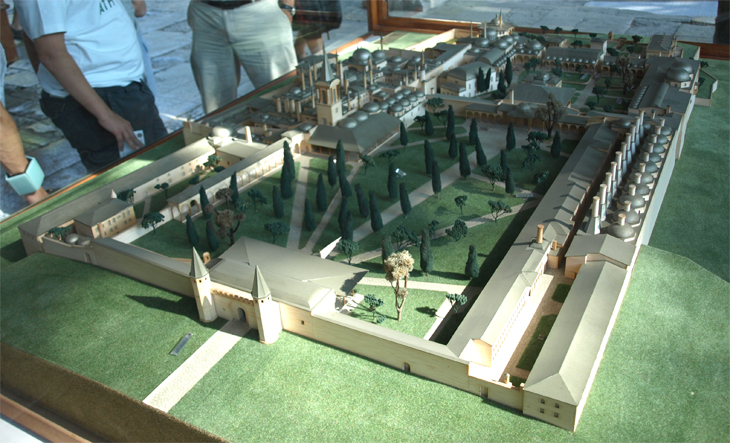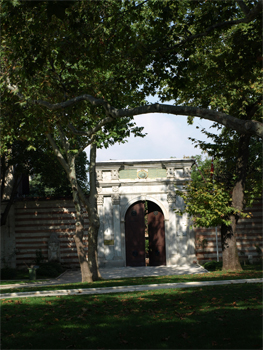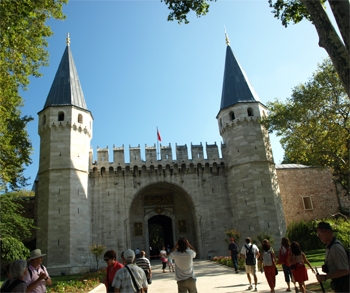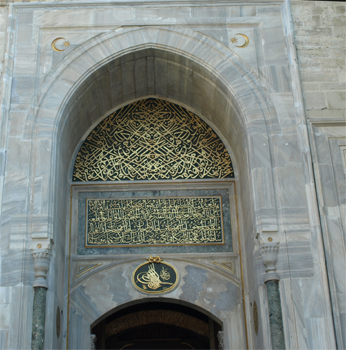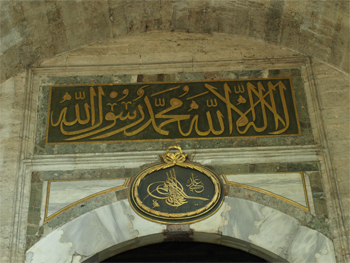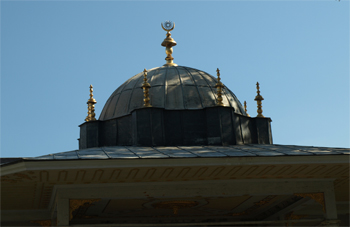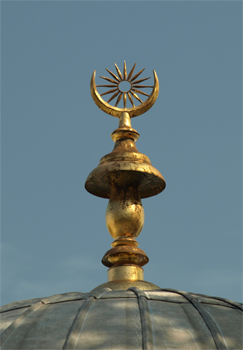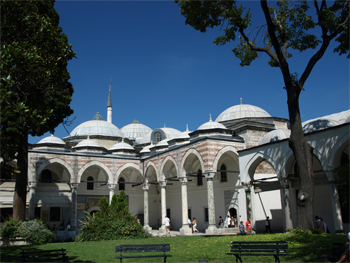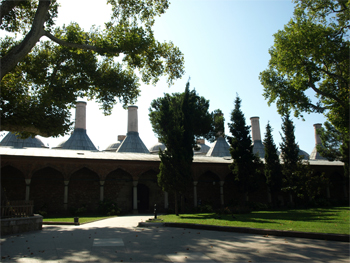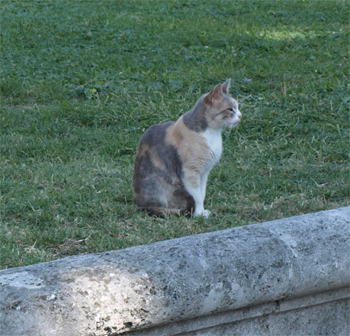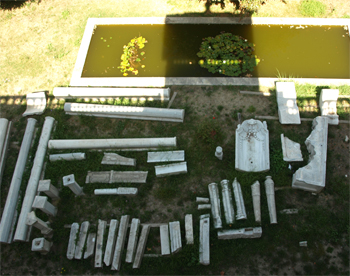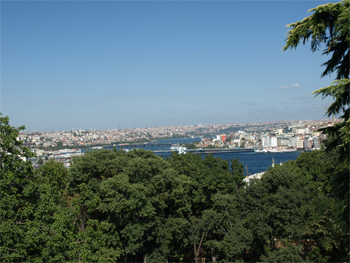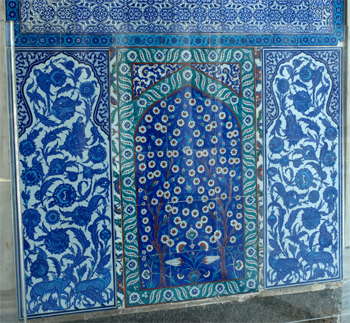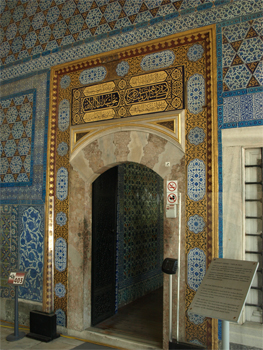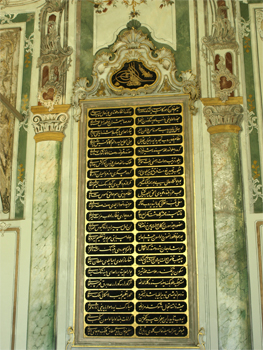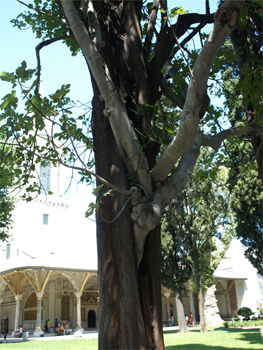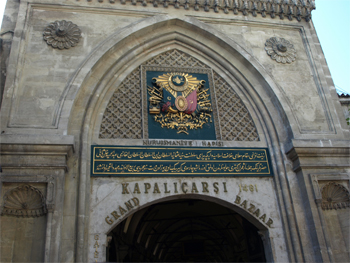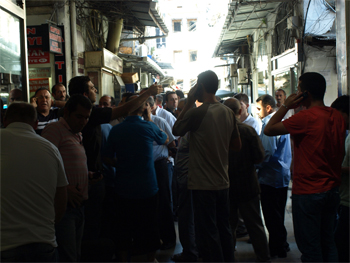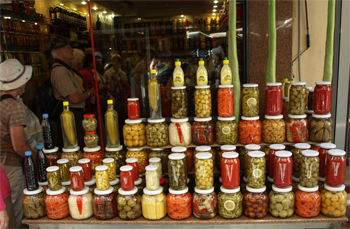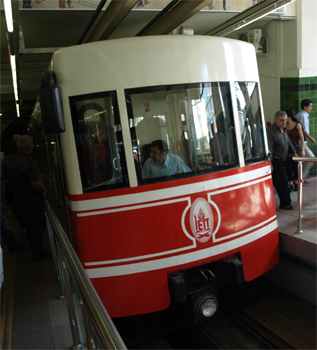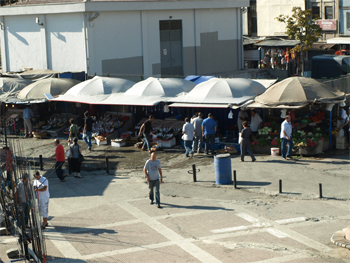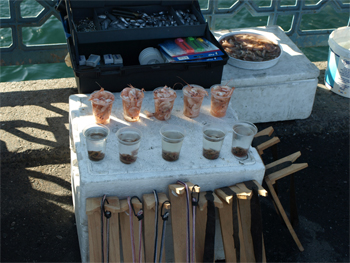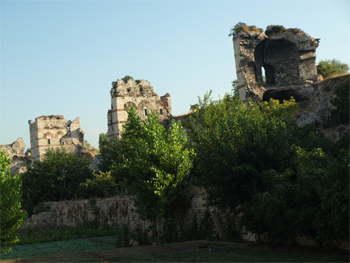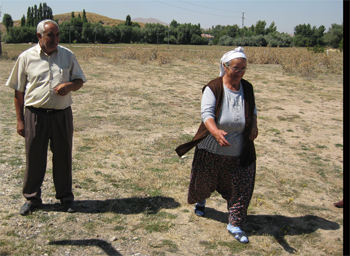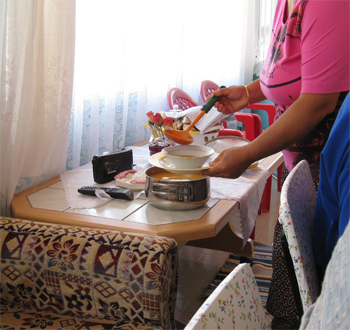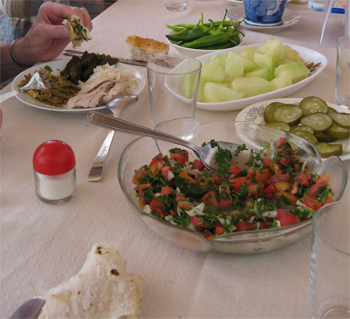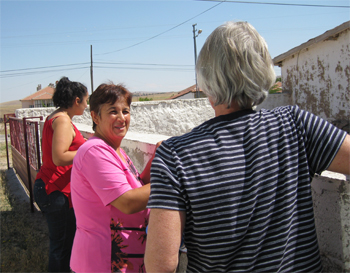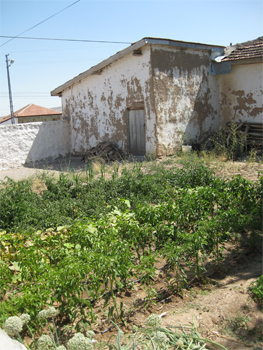Today we toured Topkapi Palace. We walked from our hotel and stopped at the elaborate Sultan Ahmed III public water fountain outside the outer palace wall. Since most houses did not have running water, the fountains around the city supplied the homes. (Link to more information about Topkapi Palace.)
|
Sultan Ahmed III public water fountain
|
Map of Topkapi Palace
|
|
Model of Topkapi Palace (first courtyard not included)
|
|
Inside the first of three courtyards is St. Irene’s Church, which was never converted to a mosque. Its dome was built to practice for the dome of Hagia Sophia. The building is now used for concerts and plays.
|
|
Also inside the first courtyard is the building now used to mint coins
|
Door to the mint
|
Building under restoration with its facade covered by an illustration of the work being done
|
Gate of Salutation - entrance to the second courtyard
|
Gate detail
|
Gate detail |
Dome of Bab-us-Saade above the Gate of Felicity |
Detail of dome
|
A gold ostrich egg hangs from the ceiling of the inner or Felicity Gate - you can barely see it in the left picture, if you look hard. It supposedly keeps spiders and spider webs away. A stone in the floor was used to hold a Turkish flag. If the flag was missing, Turkey was at war. Inside this gate is the building called the “divan court ” (hence the derivation of our term for a divan or sofa) where heads of state met with petitioners to hear their complaints. The officials lounged on the divans. The building was like the Sultan’s “Oval Office.” Inside there is a golden throne over the headman’s divan. They used running water to muffle the sounds of the conversations held there.
|
|
Divan court
|
Kitchens |
The ubiquitous cat
|
Pieces of marble from the palace buildings no doubt waiting for an ambitious archeologist to piece them together again |
We wandered on our own through the various sections of Topkapi that are now museums housing clothing of 17th and 18th century sultans, swords and armor of the troops, and jewels and medals worn by the sultans. The rubies and emeralds were huge and magnificent. The largest diamond is 59 carats, originally worn as a ring! We wandered around the beautiful grounds overlooking the Golden Horn and Bosporus Strait and through the Circumcision Chamber (royal boys were circumcised between the ages of 8 and 10) and the pavilions honoring the conquest of Baghdad. Another building housed the relics of the various Caliphs or keepers of the Koran and items that belonged to the Prophet Mohamed - including the hair trimmed off his beard!
|
The Golden Horn from the Topaki Palace grounds
|
Audience chamber |
Library of Sultan Ahmed III
|
The tiles and mosaics and marble pillars were impressive and not as gaudy as the Russian palaces we visited 3 month ago
|
|
|
|
|
|
On the council wall |
A fig grafted to a cypress - a highlight of the second courtyard! |
We looked at the harem building, but did not have tome to take that tour. The harem housed all of the Sultan’s concubines and female relatives. They were not allowed out of the building and were served by eunuchs - first black ones from Africa (any offspring would not be white) and later by white eunuchs - I guess they were sure the plan worked! Adnan told us the reason why a sultan in the Ottoman Empire kept a harem: Since he needed a son (or several sons) to continue as the ruler/sultan after his death and since so many children died in childhood, he was much more likely to have an heir to the throne if he had many sons. For this he needed many wives. It kind of makes sense. (For lots of information, put Turkish harem into Google.)
Lunch was on our own so we bought take-out “meatball-like” hoagies to share among five of us and ate in the Sultanahmet Park.
Next we motored to the Grand Bazaar. It is so huge with aisles and curves and ramps that we got all turned around but came out at the correct “cisik” (exit) in time to meet our group. Everything is sold in the bazaar. One area is called the gold row and is shop upon shop of gold, silver, and gem jewelry.
You can get lost in this place in about 10 seconds!
|
|
Entrance Gate 1
|
Typical "street" |
Aisle where men are buying and selling futures by cell phones. The noise is deafening so it has been dubbed “wall street." |
Some of the finer wares for sale
|
Next we went by motor coach to Parna and the newer section of Istanbul. We walked through the fish market (with shops also for olives, pickles, nuts, etc) and the upscale fish restaurants. Out on the main street, now a pedestrian mall with an old San Francisco style trolley running up the center of it. We strolled past fancier shops. We stopped to buy Turkish ice cream cones. I had pistachio. It is made with sheep milk and crushed orchid meal, which makes it stiffer and less drippy than our ice cream.
|
|
Pickled everything
|
Trolly
|
We got on the Istanbul funicular and rode about a mile - to the end of the line. Istanbul has a proposed subway link under the Bosporus which would reduce traffic into downtown and connect the Asian and European sides of the city. |
Istanbul funicular
|
Next “stop” was a stroll halfway across the Galata bridge which crosses the Golden Horn. There were all kinds of people fishing from the bridge and there were great views of the city.
|
Looking down on the fish market from the bridge
|
Fishing from the Galata Bridge
|
Bait |
Dinner was on our own but eight of us went together to a nearby street of restaurants and had a wonderful Turkish meal - so good we came back when we were on our own in Istanbul. I had chicken kabobs and Marge had a mixed kabob. We ended with tea or Turkish coffee - strong and thick in a little cup; we learned later how it is supposed to be drunk.
Saturday - 8/29 – Istanbul to Cappadocia
This morning on our way to the airport we stopped to look at the walls that once fortified Istanbul. There is/was a sea wall where flaming arrows and catapulted fire “bombs” were shot out to sea to repel any wooden boats that tried to attack Istanbul. Then there was a much thicker inner land wall with elaborate gates and a moat to protect against foot invaders. The moat is now filled with dirt and is used by farmers to grow tomatoes, squash, etc. It was built in 2 AD by the Romans and much of it still stands.
Roman (Constantine's) wall |
Garden moat
|
We flew Turkish Airlines to Nevsehir in the Cappadocia region. It was a short 1 ¼ hour flight with beverages, sandwich and cake.
On the way to our hotel in Uchisar, we detoured to the small village of Ilicik for a home hosted lunch. Grandma was the main cook. Mother was the hostess and her daughter was the server. I asked in sign language (none of us spoke Turkish and they did not speak English so charades and sign language had to suffice) to see the kitchen. Grandmother was so pleased she showed me the kitchen, the three bedrooms, and the bathroom. It was very simple and uncluttered. Two bedrooms had three coaches along the walls so any and all relatives could stay over when they visited. Grandmother had a real bed.
Our hosts, the village's headman and his wife, the main cook (Grandma) |
Lentil soup
|
|
We had starters of home made dill pickles, home grown melon (sweeter than our honeydew), and cheese wrapped in grape leaves. Then came lentil soup, then the little meatballs, then rice and chicken and green bean stew, and then rice pudding for dessert with green tea. It was wonderful and all prepared in a simple, neat kitchen that looked like a room from the 1950’s.
|
Grandaughter and Mother (daughter) showing Gale the garden
|
Source of many of the fresh foods on the table
|
| Return to Top | Return to Itinerary | Return to Dreamcatcher Home Page |
